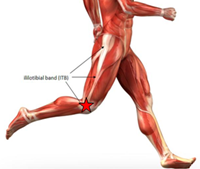 Iliotibial band syndrome (ITBS) is a common cause of outer knee pain which occurs due to irritation of the Iliotibial band (ITB) as it passes over knee. This overuse injury is commonly seen in athletes who participate in sports with repetitive knee bending such as runners, soccer players, and other endurance athletes. There are many factors that can contribute to developing ITBS, including muscular imbalances and improper movement patterns. Physiotherapy and other movement specialists can help to address these factors to prevent and effectively treat ITBS.
Iliotibial band syndrome (ITBS) is a common cause of outer knee pain which occurs due to irritation of the Iliotibial band (ITB) as it passes over knee. This overuse injury is commonly seen in athletes who participate in sports with repetitive knee bending such as runners, soccer players, and other endurance athletes. There are many factors that can contribute to developing ITBS, including muscular imbalances and improper movement patterns. Physiotherapy and other movement specialists can help to address these factors to prevent and effectively treat ITBS.
What is the IT Band?
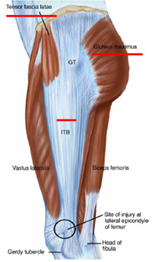 The ITB is a thick band of tissue which runs down the outer side of the hip and attaches below the outside of the knee. The band has connects to fascial tissue from muscles surrounding the hip including the gluteal muscles and the tensor fasciae latae, a muscle which flexes the hip. It provides stability to the knee joint as well as aids in bending the knee.
The ITB is a thick band of tissue which runs down the outer side of the hip and attaches below the outside of the knee. The band has connects to fascial tissue from muscles surrounding the hip including the gluteal muscles and the tensor fasciae latae, a muscle which flexes the hip. It provides stability to the knee joint as well as aids in bending the knee.
What causes ITBS?
Athletes, especially soccer players, develop specific movement patterns for sport – including dominant kick and stance legs. These repetitive movements can lead to some muscles being stronger than others. Muscular imbalances and improper movement patterns during repetitive bending of the knee can cause increased rubbing of the ITB leading to pain. Often in ITBS the gluteal muscles are weak, while TFL (pictured above) is overused and tight. This tightness in the TFL increases the pull on the IT band at the knee causing inflammation and pain.
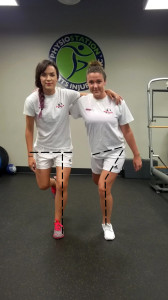 As we discussed last month in the Prevention of ACL Injuries, a common movement dysfunction in female soccer players is dynamic knee valgus. This position is shown in the picture below on the right hand player, where the knee comes inward in relation to the foot and the hip. A valgus knee can cause increased pull on the ITB leading to inflammation and pain at the attachment site. Over pronation of the foot where the arch of the foot drops inward, can also contribute to a valgus position at the knee and increased pull on the ITB.
As we discussed last month in the Prevention of ACL Injuries, a common movement dysfunction in female soccer players is dynamic knee valgus. This position is shown in the picture below on the right hand player, where the knee comes inward in relation to the foot and the hip. A valgus knee can cause increased pull on the ITB leading to inflammation and pain at the attachment site. Over pronation of the foot where the arch of the foot drops inward, can also contribute to a valgus position at the knee and increased pull on the ITB.
Potential Contributing Factors
A number of factors can lead to increased friction and pull at the ITB attachment site. When combined with repetitive bending of the knee, these can lead to ITBS:
- Muscle Weakness of the gluteals and quadriceps
- Dynamic Knee Valgus
- Over pronation of the foot
- Training Errors – can increase friction and rubbing at the ITB
- Rapid increase in training volume
- Inadequate warm up or cool down
- Poor footwear
How Do We Prevent and Treat ITBS?
A physiotherapist or movement specialist can identify improper movement patterns that contribute to the development of ITBS. By addressing muscular weaknesses and promoting proper body mechanics ITBS can be effectively managed to decrease pain and improve function.
Optimize Training Techniques
It is important to address training errors such as overtraining, sudden volume increases and excessive hill training can be contributing factors to ITBS. To allow the inflammation to subside rest initially can be effective, and slow integration of activities after muscle weakness and body position has been addressed.
Exercises
Exercises play an important role in strengthening the weak muscle groups to promote proper body positioning. These exercises focus on strengthening the gluteus maximus and gluteus medius to stabilize the hip and knee. This off loads the strain of the ITB at the knee and promotes proper movement patterning.
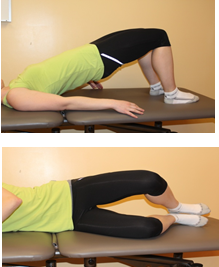 Glut Bridging
Glut Bridging
Start lying with on your back with your knees bent, feet flat on the ground. Engage your core, buttocks and thighs while lifting your trunk off the ground till it is in line with your knees.
Clam Shell
Start lying on your side with hips and knees bent. Keeping your feet together, engage your core and buttocks lifting the top knee up to the ceiling. Keep Your back straight – you should feel this in your buttocks.
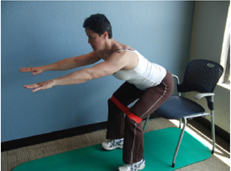 Squat with Resisted Hip Abduction
Squat with Resisted Hip Abduction
This is an intermediate exercise to promote glut strengthening and knee control. Start in a standing position with band just above the knees. Sit backwards into a squat position ensuring good knee alignment (knee in line with hip, and 2nd toe). Return to standing, keeping tension on the band.
Foam Rolling
Foam rolling is a method of myofascial release to improve blood flow to muscles and their covering (fascia) as well as improve movement and length in tight muscles. Rolling the hip muscles in combination with stretching has been shown in research to decrease pain at the ITB, increases blood flow to the area to promote healing.
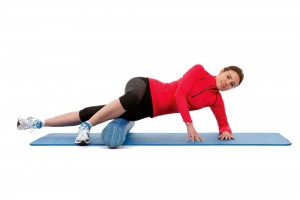 Foam Rolling ITB
Foam Rolling ITB
Roll along the side of the hip, and glut muscles as well as just above the knee close to the attachment of the ITB. Foam rolling can be uncomfortable, but shouldn’t cause severe pain. It is recommended to roll each muscle for about 1-2 minutes.
ITBS is a common over use injury that is often seen in soccer players, and other endurance athletes. Due to the repetitive nature of these sports muscle imbalances and improper movement patterns can occur. With proper exercises to strengthen weak muscles and movements to maintain alignment of the hip and knee ITBS can be effectively treated. Physiotherapists are movement specialists that have training to assess the alignment of the lower body and can help to address these muscular imbalances.
If you have any questions about the information here please contact Kadi Nicholson, Physiotherapist at 604-372-0808. If you would like to book an appointment with a Physiotherapist for a movement analysis call Physiostation at 604-372-0808 or complete our online form.
References
Grand Rounds Project PT 864 ITBS written by Matthew Romano, Kathryn Jung, Kadi Nicholson, Lindsay O’Leary
Baker, R. L., Souza, R.B., & Fredericson, M. (2011). Iliotibial Band Syndrome: Soft Tissue and Biomechanical Factors in Evaluation and Treatment. PM&R, 3, 550-561.
Written by Kadi Nicholson, Registered PT, MScPT, BScKin